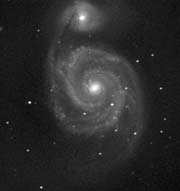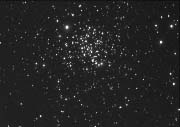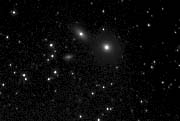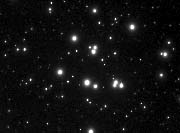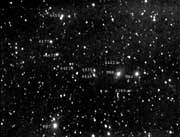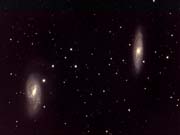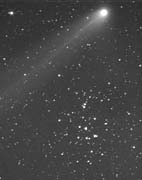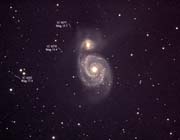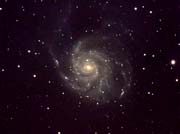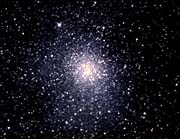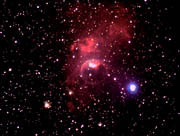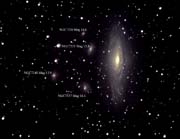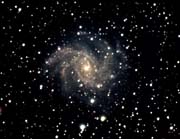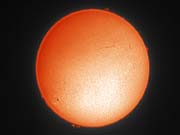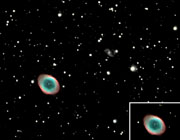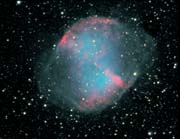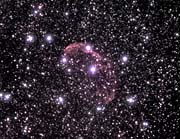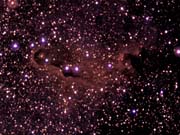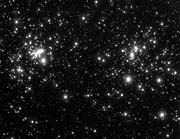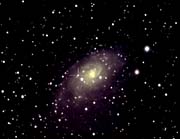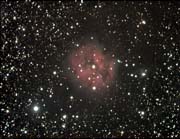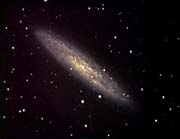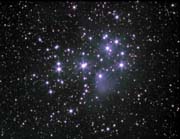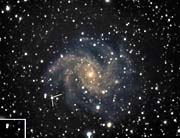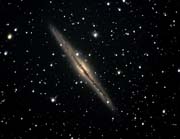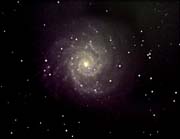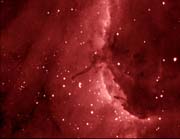|
Again the weather has been unfavourable to say the least,
but on 17th. February the skies cleared, and with no wind I
was able to revisit a number of objects. All images MX716
with LX90 at f6.3, unguided 1 minute frames stacked. Firstly
NGC 3190 in Leo - a very nice galaxy group, and a much
better image than my previous attempt.
|
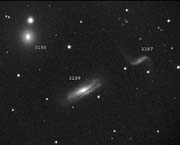
|
|
Then a go at Hoag's object, previously
imaged with the 20 inch telescope at COAA. With the
smaller telescope and lower altitude I was pleased to be
able to detect this 16th magnitude galaxy, even though I did
not resolve the ring. But I'll keep trying!
|

|
|
M81 was high overhead, so much so that I had to install a
diagonal to prevent mount clashes with the camera. The
increased spacing from the focal reducer also increased the
field of view slightly, allowing me to encompass almost all
the galaxy.
|
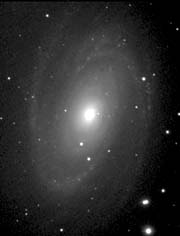
|
|
The night of 7/8th. December was a
cracker! Clear skies from dusk to dawn, and I worked right
through! A bit of time spent refining my polar alignment,
then I started imaging around 9 pm. The first target was a
repeat visit to Stephan's Quintet in Pegasus, previously
imaged from Boldon, but this time at a higher resolution
with the MX716 and Mirage at f10. L 11 frames x 3 minutes,
RGB each 5 minutes. The galaxy group is made up of NGCs
7317, 7318-1, 7318-2, 7319 and 7320. Nearby there is also
fainter 7320C.
|
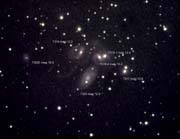
|
|
While looking in Skymap for likely
targets I came across mag 10.6 NGC1055, near Messier 77 in
Cetus. It looked to be an interesting object with a
prominent dust lane. I wasn't disappointed! MX716 and Mirage
at f6.3. L 8 x 5 minutes, RGB each 3 minutes fast
hi-res.
|
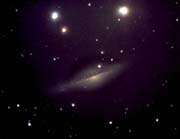
|
|
Messier 77, (Cetus A) was right next
door, so obviously the next to visit. This compact galaxy is
mag 8.9, also with interesting dark lanes, but this time
face on. MX716 and Mirage at f10. L 15 x 3 minutes, RGB each
4 minutes.
|
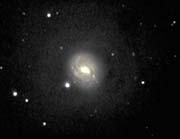
|
|
For the remaining three images of the
night I fitted the MX716 to my 135 mm camera lens for some
larger targets. First was NGC 2237 - the Rosette Nebula in
Monoceros. This object is BIG - almost 3 times the size of
the Moon, but faint and diffuse and a difficult target
visually. But the MX716 captures it nicely! L 8 x 6 minutes,
RGB each 6 minutes.
|

|
|
I first came across Kemble's Cascade
in the Philip's Observers Handbook 'Astronomy from Towns and
Suburbs'. The asterism was originally mentioned by Lucian J.
Kemble in a letter to Walter Scott Houston in 1980. A
magnificent cascade of stars splashing into the small open
cluster NGC 1502 in Camelopardalis, and a fine binocular
object. L 6 x 5 minutes, RGB each 5 minutes.
|
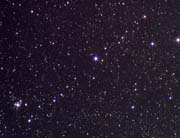
|
|
With morning approaching, I quickly visited Messier 44,
Praesepe or the Beehive in Cancer. The MX716 with the 135 mm
lens nicely encompasses this large naked eye cluster. L 5 x
5 minutes, RGB each 3 minutes fast hi-res.
|
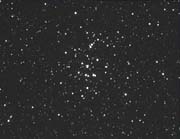
|
|
As if 7/8th. December wasn't enough,
the 9/10th again showed promise. I'd been out, and got home
about 10.30 pm. Foggy in the valley, but as I climbed the
last 100 feet or so to Plover Hill, I came up out of it to
clear skies. The fog over Hexham, and indeed all the urban
areas even as far as Newcastle 25 miles away, shut out
almost all light pollution, and the skies remained
beautifully dark all night. Still a bit hazy, so my first
targets were affected by this. NGC772, is a nicely shaped
spiral galaxy in Aries, magnitude 10.6 with nearby fainter
galaxies. The two with queries aren't shown in Skymap. MX716
and Mirage at f6.3 L 6 x 5 minutes, RGB each 5 minutes.
|
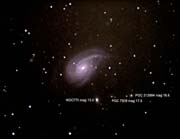
|
|
Comet C/2004 Q2 Machholz was now rising, and at 5th
magnitude and 15 degrees altitude was worth imaging. This
comet will continue to rise and brighten over the next
month, so I hope to obtain more images showing changes as it
approaches the Sun. MX716, Mirage at f6.3. 5 x 1 minute
frames.
|
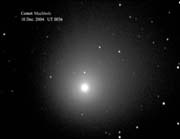
|
|
Still low to the South, I then went
for the small Globular cluster Messier 79 in Lepus. This was
affected by horizon haze and turbulence, but at only 10
degrees altitude, I was thankful to get a halfway decent
image. Mirage at f6.3, 10 x 1 minute frames.
|
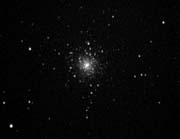
|
|
Messier 50 in Monoceros next crossed the Meridian at 26
degrees altitude, and with the mist also clearing, I
obtained a satisfactory image. The MX716 with Mirage at f6.3
nicely framed the cluster. L 10 x 1 minutes, RGB each 1
min.
|
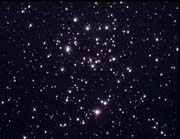
|
|
I then spent some time trying out autoguiding using my
webcam and AT1010. Mixed success - needs more work. But
before packing in I decided to image Messier 82 which was
high in the sky in Ursa Major. And I'm glad I did so. The
exceptionally dark sky gave very good contrast, allowing
processing to bring out as much detail as possible. The air
was slightly turbulent, so a little fine detail lost, but
I'm quite pleased with it! MX716, Mirage at f10. L 9 x 3
minutes, RGB each 3 minutes.
|
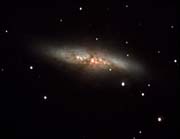
|
